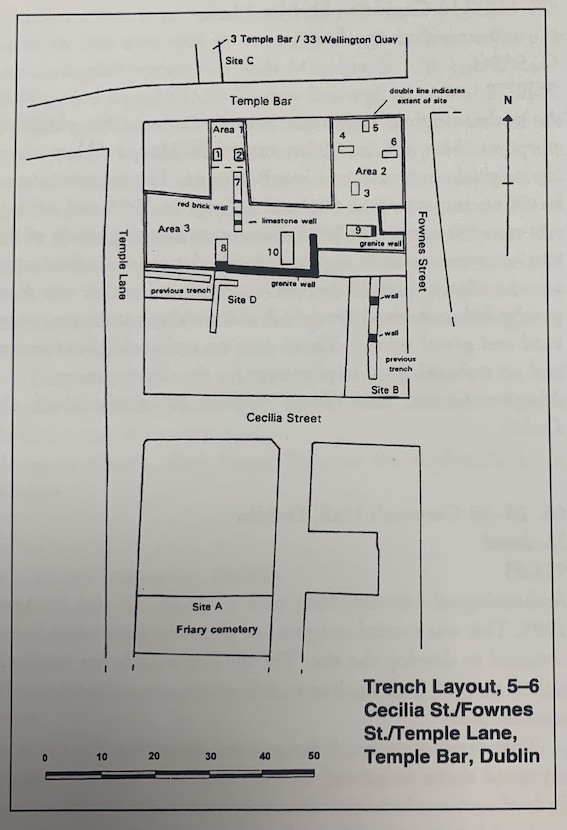County: Dublin Site name: DUBLIN: 5–6 Cecilia St./Fownes St./Temple Lane, Temple Bar
Sites and Monuments Record No.: N/A Licence number: 95E0068
Author: Margaret Gowen
Site type: Religious house - Augustinian friars
Period/Dating: Late Medieval (AD 1100-AD 1599)
ITM: E 715526m, N 734126m
Latitude, Longitude (decimal degrees): 53.344734, -6.265019
Preliminary archaeological assessment was carried out as part of a planning submission for the redevelopment of three adjoining sites which eventually formed five separate planning applications. The assessment was carried out on sites bounded by Temple Lane, Cecilia St. and Fownes St. Upper. Based on cartographic and documentary sources the block was thought to be the site of the Augustinian friary, dedicated to the Holy Trinity, reputedly founded in c. 1259. Prof. Father F.X. Martin, who made a study of the Augustinian houses in Ireland, indicated that the earliest mention of this site occurs in a will dated to 1282. By tradition, the friary is said to have been founded by the Talbot family; they are recorded as having enlarged their property in the late medieval period. A general college for the Augustinian Friars was established as part of this foundation in the late 14th century.
Three test-trenches were opened on the site. On the west side a deposit of archaeologically enriched clay up to 1.2m thick may relate to the occupation of the friary. No structural remains were revealed in the two very small trenches on this side. To the north, 17th-century reclamation fill covered a thin sequence of possible medieval deposits. (The development of a portion of the area assessed received a planning permission without further assessment of that site. An archaeological excavation was carried out by Linzi Simpson during February/March 1996 and quite substantial remains of the foundations of friary structures were revealed. It is hoped to carry a report on this excavation in the Excavations bulletin for 1996.)
On the basis of the results from the areas tested, it became clear that remains of the friary, though scant, survived on the eastern side of the Cecilia House site, but in a very truncated and poorly preserved state. Essentially, the old ground level was removed on the south side of the block by the insertion of basements and there appeared to have been reuse of stone building materials derived from the friary buildings. Further planning applications will be assessed in turn and further archaeological excavation is anticipated in 1996.

Rath House, Ferndale Rd, Rathmichael, Co. Dublin